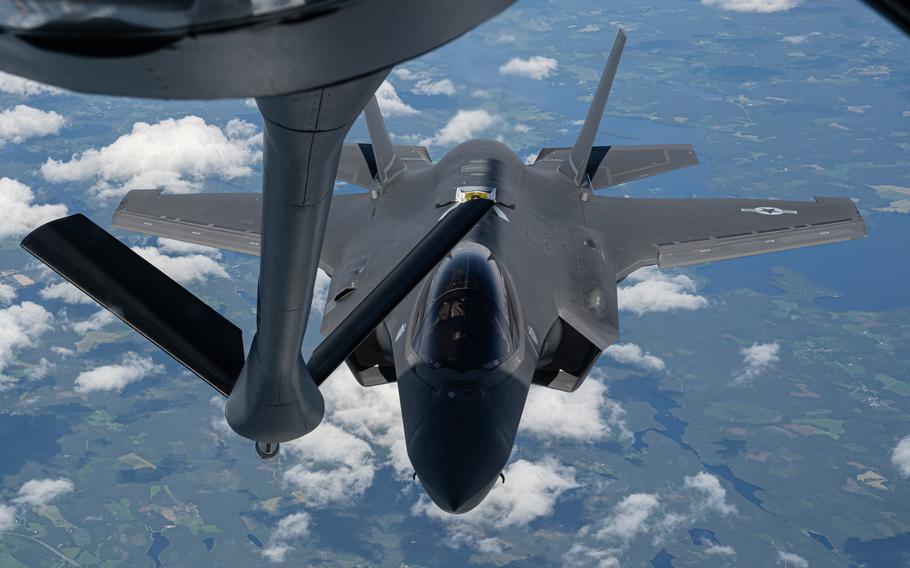
An Air Force F-35A Lightning II approaches an Air Force KC-135 Stratotanker for midair refueling over Finland on June 26, 2025. (Christopher Campbell/U.S. Air Force)
Deep cuts to the Air Force’s F-35 program and the elimination of the E-7 Wedgetail program would prove a “costly and strategic blunder” for the service, a retired three-star general said Thursday.
Retired Lt. Gen. David Deptula told reporters that the proposed cuts to the programs in the Air Force’s fiscal 2026 budget proposal unveiled last month would leave the service with problematic capability gaps given an uncertain security environment around the world. The latest budget proposal, Deptula said, would cut some 340 aircraft from the service while purchasing only 76 new airframes, including only 24 F-35As — the most advanced fighter aircraft now flying.
“The Air Force today is the oldest, the smallest and the least ready it’s ever been in its entire history,” Deptula said during a news briefing organized by the Air and Space Forces Association. “And the current programming schedule, it has [the Air Force fleet] getting even smaller as we move into the next five years, and quite frankly, there’s insufficient funding in the budget to stop that decline. That’s why raising this to the attention of Congress and the American public is so important.”
Deptula, who is the dean of the Mitchell Institute for Aerospace Studies and retired from the Air Force in 2010, helped organize a letter sent this week to congressional leaders warning of the dire consequences if the service’s budget proposal was enacted. It was signed by 16 retired four-star generals.
“During a period of heightened tension throughout the world, we believe such reductions will severely and unnecessarily undermine our service members’ ability to deter, and if necessary, prevail in future conflicts,” the generals wrote in the July 7 letter organized by the Air and Space Forces Association.
The signees included six former Air Force chiefs of staff — Gens. Merrill McPeak, Ron Fogleman, Michael Ryan, John Jumper, Michael Moseley and Mark Welsh. Other signers included Gen. Joseph Ralston, a former vice chairman of the Joint Chiefs of Staff and NATO Supreme Allied Commander; Gen. Philip Breedlove, a former NATO Supreme Allied Commander and Air Force vice chief; Gen. Ralph Eberhart, who led U.S. Northern Command; Gen. Kevin Chilton, a former U.S. Strategic Command chief; Gen. Lori Robinson, a former NORTHCOM commander; Gen. John Loh, a former Air Force vice chief, and Gen. Herbert “Hawk” Carlisle, who lead Air Combat Command.
Air Force and Pentagon leaders have defended the proposed cuts as necessary to fund the next generation of weapons. The cuts to the F-34A Lighting II fighter program would shift $3.5 billion in funds to develop the sixth-generation F-47 stealth fighter and boost funding for the Long-Range Anti-Ship Missile and an extended-range version of the Joint Air-to-Surface Standoff Missile, service officials said while rolling out the Air Force’s proposed $209.6 billion budget for 2026.
Service officials said cutting the E-7 Wedgetail program was needed due to cost overruns and uncertainty over its survivability in a combat zone. The Air Force had planned to buy 26 of the aircraft to replace older E-3 AWACs aircraft, but the service now wants to shift its surveillance emphasis to space-based satellites.
The group of retired generals warned Thursday that space-based satellites are not yet up to the task of taking over surveillance capabilities now conducted by manned aircraft.
The former top Air Force leaders said they recognized the long history of F-35 issues from cost overruns to supply-chain problems, but Congress needs to look no further than recent attacks on Iran by Israeli F-35A pilots to see the aircraft is capable.
Breedlove, a fighter pilot who retired in 2016 after leading U.S. European Command and NATO forces for three years, said Israeli pilots used the F-35A — the same model the U.S. Air Force flies — to destroy Iran’s advanced anti-aircraft systems provided by Russia, and give them full air superiority over the country. It allowed Israel — and later U.S. B-2 stealth bombers — to deliver unopposed strikes on military targets during the recent 12-day conflict between the two Middle East powers.
“You just need to look at what the Israelis just did in Iran as to how that works for us,” Breedlove said, comparing the operation to Russia’s invasion of Ukraine where it has never established air superiority. “We don’t want to end up having to fight a war that is not enabled fully by our style of Western air power and air superiority.”
The group suggested Congress purchase 75 F-35As in fiscal 2026, in part to deter China from attacking Taiwan, which its president, Xi Jinping, has vowed to return to Chinese control. Breedlove said Israel’s use of the F-35s against Iran should give Xi pause in ordering such an invasion.
“Mr. Xi … just watched the F-35 march into Iran, a long way from Israel, and establish air superiority over the enemy’s battlefield, … the F-35 did that while fighting against some of the best Russian [air defense systems] outside of Russia,” Breedlove said. “This is an inflection point for Xi — and others — that American air power … can give him pause.”
But scaling back the F-35 and the E-7 programs could change that calculus, the generals worried.
“If conflict does come, there will be no more decisive question than who controls the skies over the Pacific,” they wrote. “The actions Congress takes this year — specifically through the acquisition of 75 F-35As and ensuring the operational deployment of the E-7 — could be critical in deterring and, if necessary, prevailing in near-term conflicts.”